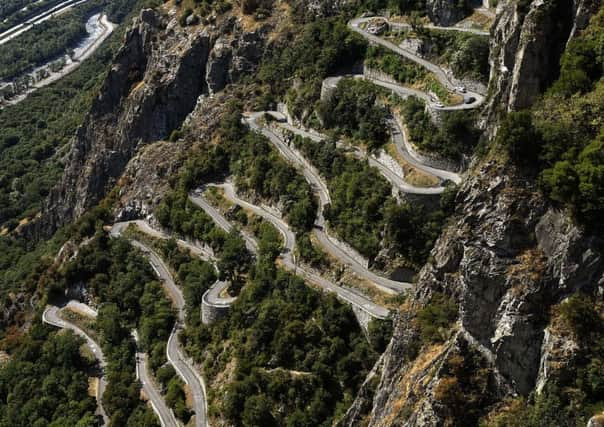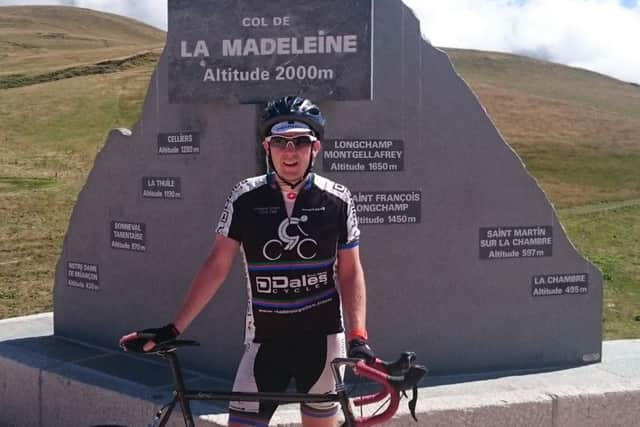Travel: Cycling down the Alps is the ride of your life


Red-faced men with lopsided grins and glossy, excitable dogs were scattered across the narrow main street of the Alpine village as dusk fell. A fug of cognac clouded the evening air, enveloping us as we pedalled past.
“Plus vite!” said a man, bursting out of his green jacket, home from the first boar hunt of the season. “Plus vite!”
Advertisement
Hide AdI could barely turn the pedals, breathless from my first experience of a short, sharp climb in the Alps. His first smile had been jocular. Seeing the state of me his second had a hint of delicious malice about it. He knew what was coming, and what it would do to me, and enjoyed the prospect far too much.


It had only been an hour-long test ride to make sure my bike survived the plane journey, but it introduced me to the casual malevolence of Alpine roads and the striking effect of the thin air, which made breathing more laboured and called for more measured efforts.
Ahead were three days of famous summits and celebrated roads, all of them high, all of them hard.
Serious road cyclists spend July infatuated with the Tour de France, tiny men on pricey bikes attacking French roads with superhuman grit and strength. Even 20 years of doping scandals have not dented aficionados’ love for the Tour, and for many the highlight are the days spent on the tortuous, heroic and dramatic climbs through the Alps.
I came here to experience those climbs, to test myself against iconic roads that have thwarted some of the pros and elevated others to the status of legend.


Alps riding is perfectly within reach of experienced amateur road cyclists. You just have to do a reasonable amount of training and be careful about how much you ride in any single day. We rode the same climbs as the pros, but at half the speed or slower, and doing many fewer miles a day.
Advertisement
Hide AdI was on guided rides and a great advantage of that is that guides will plan routes according to the ability of those in the group. If you are organising your own itinerary then plan for short distances to compensate for the ascents. On a typical day you will climb 10,000 to 14,000 feet, so it’s best to keep distances down to 50 or 60 miles a day if you can.
On the first of three days we rode some of the local roads around our chalet near Meribel. Though this was billed as something of a warm up because it involved four smaller climbs rather than one big one, each of those four was bigger than any I had done in Scotland. We rode up to Montagny and sailed along the ‘balcony road’ which twisted as it hugged the mountain a couple of thousand feet above the valley floor, spilling us out of short descents and throwing sharp little climbs in our way. It was fast and thrilling.
Advertisement
Hide AdWe kept climbing and ended up at the very end of the road, past Palognan-la-Vanoise, stopping for coffee at a ‘refuge’, described to us by a guide who had done ski seasons in Aviemore as being the Alpine version of a bothy, though not many of those are fully staffed and serve cooked meals.
As I sipped strong coffee and panted the light air into my lungs I gazed up at the valley beyond the end of the road where thin grass turned to rockfall scree and two high ridges ran away to the horizon. With its air of grand desolation in the brittle yellow sunlight of the high peaks the valley could easily have been a pass in Hindu Kush, such was its bleakness.
Two horses clopped past and I filled my water bottle from a rusting spring-fed pipe and raced down the hill, thoughts filled with how to overtake the van in front, leaving the bright serenity of the high mountain pass far behind.
Over the next two days we cycled more famous, and more major, climbs.
We followed in the tyre marks of the 2015 Tour de France, which tackled the striking Lacets de Montvernier for the first time. It is a short and steep set of 18 hairpin bends that still sported graffiti urging Britain’s Yates brothers on that threw us out on to a wide, sunny plain.
As I foolishly relaxed into an easy rhythm on the flattish stretch Andy the guide pointed ahead. High above, a road had been carved in a steep diagonal across a yellow-brown sandstone cliff face. “That’s where we’re going,” he said and I wished I hadn’t looked up.
Advertisement
Hide AdI slogged up shadow-dappled forest roads and, as the trees thinned, came to the cliff road of the Col du Chaussy. It clung precariously to the edge of the rockface and I looked out at a deep blue autumn sky, a cool breeze blowing away the heat of the lower slopes.
Just a rusting green iron fence separated us from the drop off the cliff face. It stood stout on some corners as we swung out into the sky, the valley spread below us, and on others it crumbled away to nothing, collapsed with the road’s erosion, trapping us between the overhanging rocks and a sheer drop.
Advertisement
Hide AdIt was a breathtaking road, challenging, varied and beautiful. The bigger Col de la Madeleine was pretty as it snaked between prosperous skiing villages and through lush meadows up to a barren peak, but it could not match the Col du Chaussy for drama.
The height you gain on these long, steady climbs is staggering. As we approached the top of the Madeleine from the south side, Mont Blanc slowly revealed itself. We were so high that we were looking its snow-covered south face straight in the eye, the sharp peaks of this whole area of the Alps stretching away in every direction. It was an unusually clear day, adrenaline masked the muscle pain and more coffee was on the way at the hilltop cafe. With our start point 5,000 feet below us and my heart still thumping with the effort I felt awe and pride in equal measure.
Every ride had its oddities. A high mountain plain contained a mysteriously chopped-in-half looking Scandinavian style church beside a long, straight road to nowhere; a 5,000 year old stone circle sat atop the mountain pass into Italy where locals say Hannibal drove his elephants; bustling but shadow-darkened valleys were oddly cold, not reached by the sun until lunchtime even in late summer, and countless immaculate, well heeled villages sat desolately empty, waiting for the winter ski trade that keeps the whole area afloat.
I went to the Alps for sport, not expecting these quirks or the richness of the life lived between these imposing peaks and the intimate view of it all that you get from the saddle.
It seemed to me that even the leather-capped drivers of 1930s sports cars on a city to city rally that roared and trumpeted their way past us on the Col de la Madeleine wished they were on bikes, the slowest, the hardest and without doubt the most rewarding way to experience the Alps.
• Matthew Magee rode with Cycle Hame tours (www.cyclehame.co.uk). Week long tours start at £650